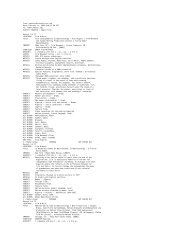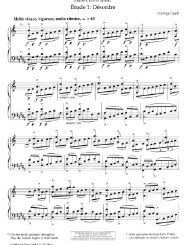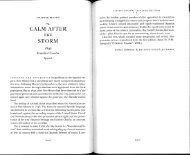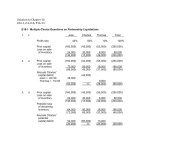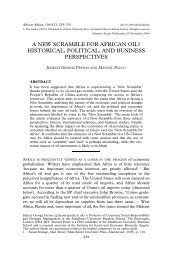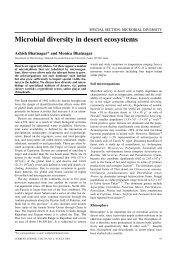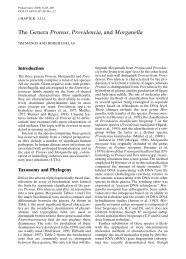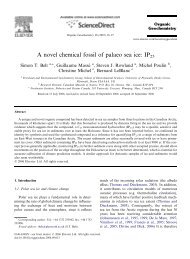Analysis by Key: Another Look at Modulation
Analysis by Key: Another Look at Modulation
Analysis by Key: Another Look at Modulation
Create successful ePaper yourself
Turn your PDF publications into a flip-book with our unique Google optimized e-Paper software.
CAR I SCHACHTER<br />
di<strong>at</strong>onic framework, would contain real modul<strong>at</strong>ions to self-contained keys.<br />
Schenker's l<strong>at</strong>er writings often retain his earlier terminology, whose meaning<br />
shifts with the evolution of his thought; making life easier for his readers <strong>by</strong><br />
explaining these shifts is not his way. Thus his final formul<strong>at</strong>ion in Free<br />
Composition includes the notions of di<strong>at</strong>ony, tonality and illusory key. Now,<br />
however, the terms di<strong>at</strong>ony and tonality apply to whole pieces. The conjunctly<br />
ordered pitches of the major and minor scales, functioning in rel<strong>at</strong>ion to the<br />
tonic centre (r<strong>at</strong>her than as a mere 'collection' as in some other conceptions of<br />
di<strong>at</strong>onicism), form the m<strong>at</strong>erials of di<strong>at</strong>ony; this notion is most clearly<br />
exemplified in the pitch contents of the Fundamental Line, with its motion<br />
directed to the tonic note as goal. It is essentially the practice of counterpoint,<br />
based on a clear distinction between consonance (octave, fifth, third) and<br />
passing dissonance th<strong>at</strong> organizes the line around a centre r<strong>at</strong>her than leaving it<br />
a mere succession of pitches.23 This di<strong>at</strong>onic structure, no longer conceived as<br />
localized, abides implicitly throughout the piece, even where the music is most<br />
chrom<strong>at</strong>ic or moves into the most distant keys, r<strong>at</strong>her like the pantheists' God,<br />
who indwells in every aspect and phase of N<strong>at</strong>ure.24<br />
The term 'tonality' is applied to the enriched tonal contents of the<br />
foreground, unified, like the simple elements of di<strong>at</strong>ony, through their rel<strong>at</strong>ion<br />
to the tonic; these contents may include both local chrom<strong>at</strong>icism and<br />
modul<strong>at</strong>ion to illusory keys.25 If di<strong>at</strong>ony perme<strong>at</strong>es the whole piece, then the<br />
'real modul<strong>at</strong>ions' th<strong>at</strong> Schenker discusses in the Harmonielehre - changes of key<br />
th<strong>at</strong> cannot be subsumed under a controlling di<strong>at</strong>onic structure - must be nonexistent.<br />
All of the keys of the piece, therefore, turn out to be like the<br />
Scheintonarten, or illusory keys, of the earlier theory; and preserving the terms<br />
shows how much of Schenker's l<strong>at</strong>er theory was already implicit in his earlier.<br />
But if all keys (other than the unfolded tonic of the underlying di<strong>at</strong>ony) are<br />
illusory, why bother with the adjective <strong>at</strong> all? It seems less useful than in the<br />
Harmonielehre, where only some of the keys in a piece are conceived as illusory.<br />
In addition to preserving his own earlier terminology, Schenker probably<br />
wanted to emphasize the monotonality of his l<strong>at</strong>er theory, which holds th<strong>at</strong> in a<br />
deep sense each piece can have only one 'real' tonic. The notion th<strong>at</strong> a piece can<br />
be a unified structure in one main key and <strong>at</strong> the same time traverse several other<br />
secondary keys is very hard to express in terminology th<strong>at</strong> does not seem selfcontradictory.<br />
Schoenberg has a point when he criticizes Schenker's term<br />
'toniciz<strong>at</strong>ion'; after all, he says, each key (Tonart) has only one tonic. Yet<br />
Schoenberg does more or less the same thing when he uses Roman numerals to<br />
analyse music in non-tonic regions. Wh<strong>at</strong> does 'I' in the Subdominant Region<br />
mean, if not a local tonic?26<br />
Schenker's referring to 'illusory keys' gives him a way out of this<br />
terminological difficulty, but it is perhaps the quick and safe r<strong>at</strong>her than the<br />
scenic route. By lumping all 'keys' together into a single c<strong>at</strong>egory, Schenker<br />
necessarily tre<strong>at</strong>s the subject of modul<strong>at</strong>ion in a far less differenti<strong>at</strong>ed way than<br />
in the Harmonielehre, which distinguishes between toniciz<strong>at</strong>ions, illusory keys<br />
and real modul<strong>at</strong>ions. Furthermore, <strong>by</strong> loc<strong>at</strong>ing all 'keys' <strong>at</strong> the foreground<br />
306 MUSIC ANALYSlS 6: 3, 1987



